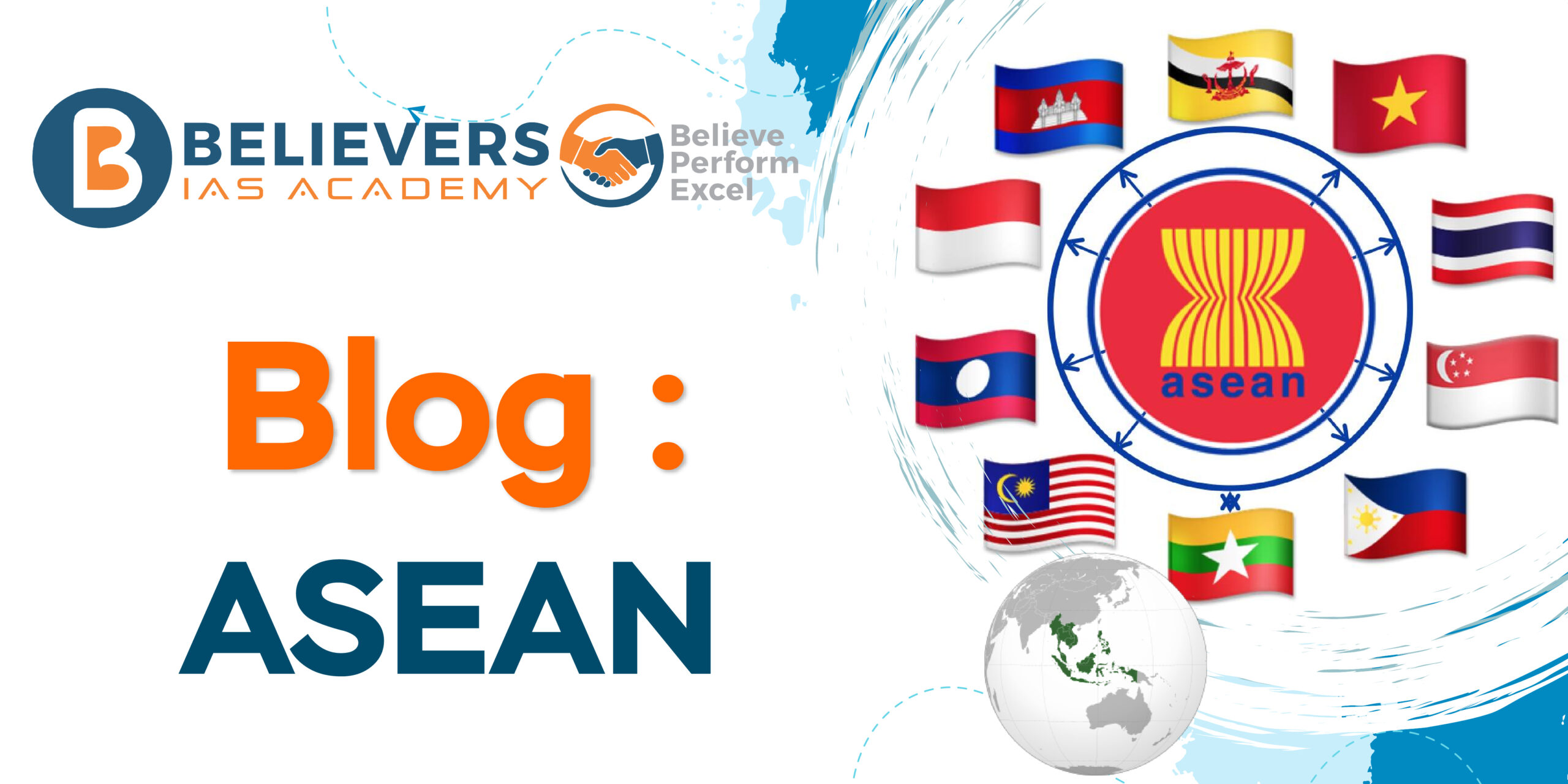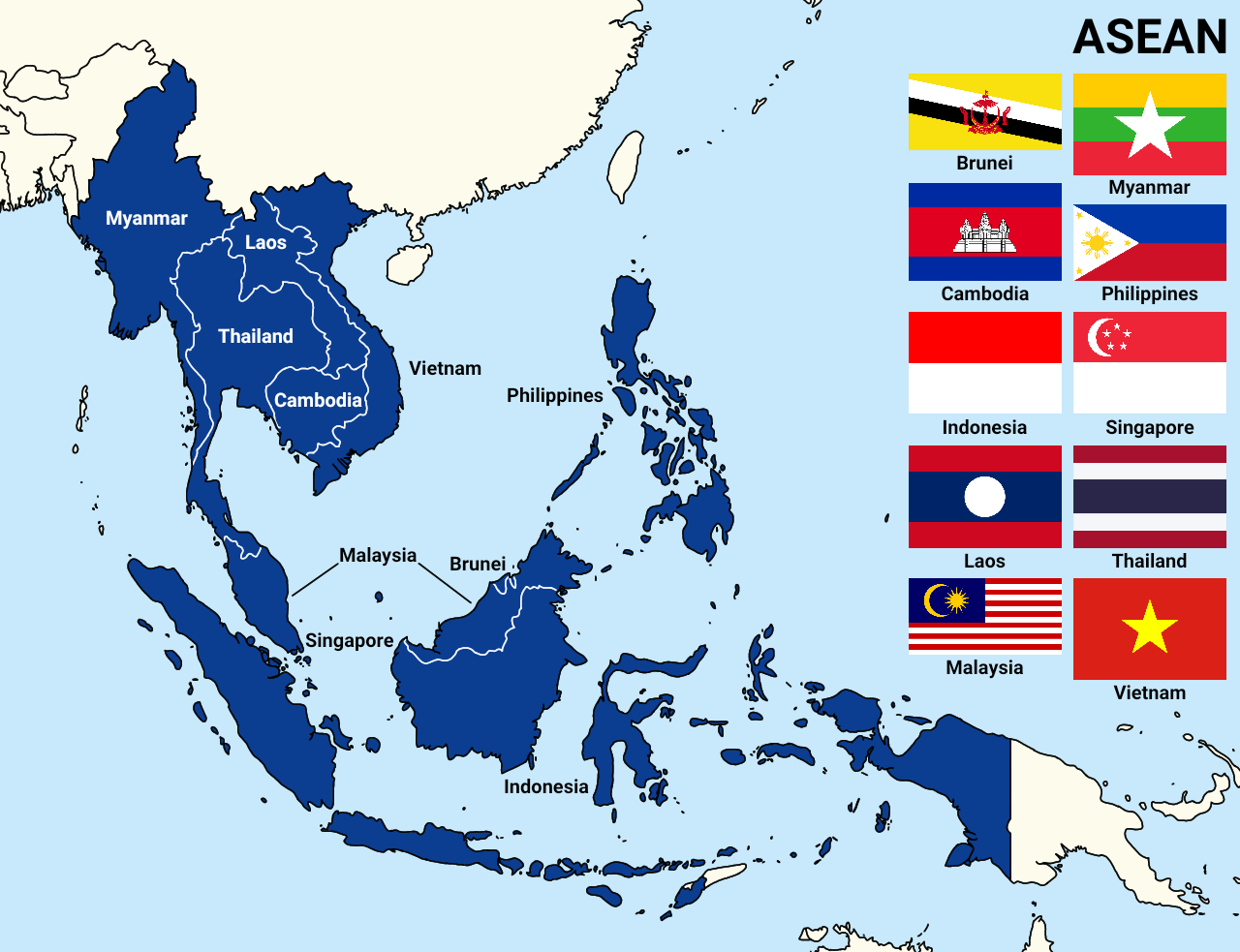ASEAN
ASEAN, or the Association of Southeast Asian Nations, is a Southeast Asian regional organization with 10 member countries. The ASEAN Declaration was signed on August 8, 1967, by the foreign ministers of Indonesia, Malaysia, the Philippines, Singapore, and Thailand. ASEAN has evolved and expanded its ambitions beyond its basic goal of limiting communism to become a significant regional political and economic union.
Who are the Member Countries of ASEAN?
- Brunei
- Cambodia
- Indonesia
- Laos
- Malaysia
- Myanmar,
- Philippines
- Singapore
- Thailand
- Vietnam.
What is the historical background behind the ASEAN?
- Context after WWII: Following World War II, numerous Southeast Asian nations obtained or were on their way to attaining independence from colonial powers. This period saw a substantial upheaval in the political environment of the region.
- Communist Invasion: Southeast Asian nations were concerned about the expansion of communism, notably the success of the Chinese Communist Party in 1949 and the Korean War. The “domino theory,” or the fear of communism spreading to Southeast Asia, was a major concern for both Western powers, particularly the United States, and newly independent Southeast Asian nations.
- Southeast Asia Treaty Organization (SEATO): In 1954, the United States, the United Kingdom, Australia, New Zealand, France, Pakistan, the Philippines, and Thailand founded SEATO to confront the perceived threat of communism in Southeast Asia. SEATO was a collective defence treaty designed to keep communism from spreading in the region.
- Early Regional Cooperation: Before the foundation of ASEAN, there were several early attempts at regional cooperation in Southeast Asia. Notably, the forerunner to the Southeast Asian Games (SEA Games), the Southeast Asia Peninsular Games (SEAP Games), began in 1959 as a regional sporting event.
- Formation of ASA: The Association of Southeast Asia (ASA) was founded in 1961 by Thailand, the Philippines, and the Federation of Malaya (which eventually became Malaysia). The purpose of ASA was to encourage economic and cultural cooperation among its members.
- ASEAN Declaration: The ASEAN Declaration was signed in Bangkok on August 8, 1967, by the foreign ministers of Indonesia, Malaysia, the Philippines, Singapore, and Thailand, and it was a watershed point in the founding of ASEAN. ASEAN was officially established with this announcement. The original five member states were dubbed the “ASEAN-5.”
- Economic Cooperation: While ASEAN initially stressed security and political cooperation, it has increasingly emphasized economic integration as a means of supporting regional stability and growth. The ASEAN Free Trade Agreement (AFTA) was created in 1992 to boost trade and investment between member countries.
- ASEAN Community: In 2003, ASEAN began the process of establishing an ASEAN Community, which would be comprised of three pillars: the ASEAN Security Community, the ASEAN Economic Community, and the ASEAN Socio-Cultural Community. This effort sought to strengthen regional integration.
What are the Three Pillars of the ASEAN groupings?
The Association of Southeast Asian Nations (ASEAN) is built on three pillars:
- ASEAN Political and Security Community (APSC)
- The ASEAN Economic Community (AEC) was established in 1997.
- The ASEAN Socio-Cultural Community (ASCC)
These pillars are regarded as critical to ASEAN’s and its people’s growth. They are inextricably intertwined and support one another to ensure the region’s peace, stability, and shared prosperity.
What is the ASEAN Political and Security Community(APSC)?
The ASEAN Political-Security Community (APSC) is an ASEAN pillar that focuses on regional stability and political security. The primary purpose of the APSC is to build a safe, peaceful, and stable zone along the ASEAN border. The APSC aims to strengthen ASEAN’s alliances and collaboration with various external parties, such as regional and international organizations. Cooperation areas of the APSC include:
- Terrorism and international crime
- Emergency relief
- Maritime safety
- Disarmament and non-proliferation
- Cyber security
What is the ASEAN Economic Community(AEC)?
The ASEAN Economic Community (AEC) was founded in 2003 to develop a regional single market and manufacturing base. The AEC was established to employ economic mechanisms to achieve political objectives. The AEC envisions a free flow of products, services, investments, capital, and labour. This would enable the growth of regional manufacturing networks and strengthen ASEAN’s capacity as a global supply chain.
- The AEC wants to make ASEAN a highly competitive economic bloc.
- Encourage egalitarian economic growth.
- ASEAN should be integrated into the global economy.
What is The ASEAN Socio-Cultural Community (ASCC)?
The ASEAN Socio-Cultural Community (ASCC), together with the ASEAN Economic Community (AEC) and the ASEAN Political-Security Community (APSC), is one of the three pillars of the ASEAN Community. The ASCC was founded to foster social and cultural cooperation and integration among the Association of Southeast Asian Nations (ASEAN) member states. It aims to improve the region’s people’s well-being and quality of life.
What are the objectives of the ASEAN grouping?
ASEAN’s key aims are as follows:
- Accelerate Economic Growth: Promoting economic growth and development in the region is one of ASEAN’s primary goals. Member countries collaborate to foster a favourable climate for trade, investment, and economic cooperation. The formation of the ASEAN Economic Community (AEC) is an important step in achieving this goal.
- Promote Regional Peace and Stability: ASEAN’s goal is to keep Southeast Asia peaceful and stable. Member nations pledge to resolve conflicts peacefully, to uphold the values of the United Nations Charter, and to develop good neighbourly relations.
- Improve Social Progress: ASEAN strives to improve its people’s well-being and quality of life. Efforts to address social challenges, promote social justice, safeguard human rights, and assure access to healthcare and education are all part of this.
- Cultural Development: Cultural heritage preservation and promotion, as well as cultural exchange among member nations, are significant goals. ASEAN stresses the importance of cultural variety in developing national unity and understanding.
- Collaboration on Common Interest areas: Member states commit to collaborate on areas of mutual interest, which can encompass economic, social, cultural, scientific, and technological fields. ASEAN serves as a forum for collaboration and information exchange.
What is India’s Role in ASEAN Grouping?
- The involvement of India in ASEAN (the Association of Southeast Asian Nations) is diverse and has evolved. India’s relationship with ASEAN is led by its “Look East” strategy, which was later updated to “Act East,” indicating a more proactive and dynamic approach. Here is a summary of India’s position in ASEAN:
- Strategic Alliance: India and ASEAN have a strategic alliance. This collaboration spans multiple domains, including political, economic, security, and sociocultural cooperation. It underlines India’s commitment to strengthening ties with ASEAN members.
- Economic Cooperation: Economic cooperation is an important part of India’s connection with ASEAN. The ASEAN-India Free Trade Area, which aims to encourage trade and investment between India and ASEAN member countries, is a member of India. In addition, India has been an active participant in regional economic conferences such as the ASEAN Regional Forum (ARF) and the East Asia Summit (EAS).
- Security and defence: India works with ASEAN member countries on security and defence matters such as counter-terrorism, maritime security, and disaster management. To improve security in the Indian Ocean and Southeast Asian regions, the Indian Navy undertakes joint exercises and patrols with many ASEAN states.
- Cultural and Educational Exchanges: India encourages cultural and educational exchanges with ASEAN countries. This comprises student grants, cultural events, and academic institution connections.





